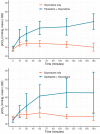Effects of sedative psychotropic drugs combined with oxycodone on respiratory depression in the rat
- PMID: 34080766
- PMCID: PMC8604244
- DOI: 10.1111/cts.13080
Effects of sedative psychotropic drugs combined with oxycodone on respiratory depression in the rat
Abstract
Following a decision to require label warnings for concurrent use of opioids and benzodiazepines and increased risk of respiratory depression and death, the US Food and Drug Administratioin (FDA) recognized that other sedative psychotropic drugs may be substituted for benzodiazepines and be used concurrently with opioids. In some cases, data on the ability of these alternatives to depress respiration alone or in conjunction with an opioid are lacking. A nonclinical in vivo model was developed that could detect worsening respiratory depression when a benzodiazepine (diazepam) was used in combination with an opioid (oxycodone) compared to the opioid alone based on an increased arterial partial pressure of carbon dioxide (pCO2 ). The current study used that model to assess the impact on respiration of non-benzodiazepine sedative psychotropic drugs representative of different drug classes (clozapine, quetiapine, risperidone, zolpidem, trazodone, carisoprodol, cyclobenzaprine, mirtazapine, topiramate, paroxetine, duloxetine, ramelteon, and suvorexant) administered alone and with oxycodone. At clinically relevant exposures, paroxetine, trazodone, and quetiapine given with oxycodone significantly increased pCO2 above the oxycodone effect. Analyses indicated that most pCO2 interaction effects were due to pharmacokinetic interactions resulting in increased oxycodone exposure. Increased pCO2 recorded with oxycodone-paroxetine co-administration exceeded expected effects from only drug exposure suggesting another mechanism for the increased pharmacodynamic response. This study identified drug-drug interaction effects depressing respiration in an animal model when quetiapine or paroxetine were co-administered with oxycodone. Clinical pharmacodynamic drug interaction studies are being conducted with these drugs to assess translatability of these findings.
Published 2021. This article is a U.S. Government work and is in the public domain in the USA. Clinical and Translational Science published by Wiley Periodicals LLC on behalf of the American Society for Clinical Pharmacology and Therapeutics.
Conflict of interest statement
The authors declared no competing interests for this work.
Figures


Similar articles
-
Effect of Paroxetine or Quetiapine Combined With Oxycodone vs Oxycodone Alone on Ventilation During Hypercapnia: A Randomized Clinical Trial.JAMA. 2022 Oct 11;328(14):1405-1414. doi: 10.1001/jama.2022.17735. JAMA. 2022. PMID: 36219407 Free PMC article. Clinical Trial.
-
Developing an animal model to detect drug-drug interactions impacting drug-induced respiratory depression.Toxicol Rep. 2020 Jan 25;7:188-197. doi: 10.1016/j.toxrep.2020.01.008. eCollection 2020. Toxicol Rep. 2020. PMID: 32021808 Free PMC article.
-
Mortality and concurrent use of opioids and hypnotics in older patients: A retrospective cohort study.PLoS Med. 2021 Jul 15;18(7):e1003709. doi: 10.1371/journal.pmed.1003709. eCollection 2021 Jul. PLoS Med. 2021. PMID: 34264928 Free PMC article.
-
Respiratory depression and brain hypoxia induced by opioid drugs: Morphine, oxycodone, heroin, and fentanyl.Neuropharmacology. 2019 Jun;151:219-226. doi: 10.1016/j.neuropharm.2019.02.008. Epub 2019 Feb 5. Neuropharmacology. 2019. PMID: 30735692 Free PMC article. Review.
-
A comparison of four methods to quantify the cumulative effect of taking multiple drugs with sedative properties.Am J Geriatr Pharmacother. 2010 Oct;8(5):460-71. doi: 10.1016/j.amjopharm.2010.10.004. Am J Geriatr Pharmacother. 2010. PMID: 21335299 Review.
Cited by
-
New science, drug regulation, and emergent public health issues: The work of FDA's division of applied regulatory science.Front Med (Lausanne). 2023 Jan 19;9:1109541. doi: 10.3389/fmed.2022.1109541. eCollection 2022. Front Med (Lausanne). 2023. PMID: 36743666 Free PMC article. Review.
-
Suvorexant enhances oxycodone-induced respiratory depression in male rats.Drug Alcohol Depend. 2024 Nov 1;264:112434. doi: 10.1016/j.drugalcdep.2024.112434. Epub 2024 Sep 6. Drug Alcohol Depend. 2024. PMID: 39255740
-
Respiratory effects of oral mitragynine and oxycodone in a rodent model.Psychopharmacology (Berl). 2022 Dec;239(12):3793-3804. doi: 10.1007/s00213-022-06244-z. Epub 2022 Oct 29. Psychopharmacology (Berl). 2022. PMID: 36308562 Free PMC article.
-
Oxycodone: A Current Perspective on Its Pharmacology, Abuse, and Pharmacotherapeutic Developments.Pharmacol Rev. 2023 Nov;75(6):1062-1118. doi: 10.1124/pharmrev.121.000506. Epub 2023 Jun 15. Pharmacol Rev. 2023. PMID: 37321860 Free PMC article. Review.
-
Combined in vivo metabolic effects of quetiapine and methadone in brain and blood of rats.Arch Toxicol. 2024 Jan;98(1):289-301. doi: 10.1007/s00204-023-03620-2. Epub 2023 Oct 23. Arch Toxicol. 2024. PMID: 37870577 Free PMC article.
References
-
- SAMSA: key substance use and mental health indicators in the United States: results from the 2018 National Survey on Drug Use and Health. 2020. https://www.samhsa.gov/data/sites/default/files/cbhsq‐reports/NSDUHNatio.... Accessed March 17, 2020.
-
- Hedegaard H, Miniño AM, Warner M. Drug overdose deaths in the United States, 1999–2018. NCHS Data Brief, no 356. Hyattsville, MD: National Center for Health Statistics; 2020. - PubMed
-
- NIDA: overdose death rates (attached supplemental document: drug overdoses data document), revised March 2020. National Institute of Drug Abuse. 2020. https://www.drugabuse.gov/related‐topics/trends‐statistics/overdose‐deat.... Accessed March 17, 2020.
-
- Baltimore Commissioner of Health , Citizens petition. 2016. http://health.baltimorecity.gov/sites/default/files/Final%20Draft%20FDA%.... Accessed March 12, 2020.
Publication types
MeSH terms
Substances
LinkOut - more resources
Full Text Sources
Medical

